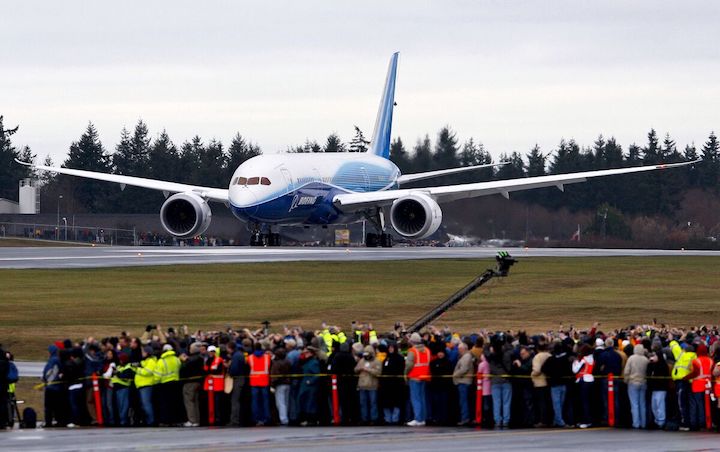Boeing to delay some 787 deliveries after finding new glitch
Boeing Co. will delay deliveries of its 787 Dreamliner after uncovering flawed parts in recent days, a setback as the planemaker works to meet soaring demand for its long-range aircraft.
Boeing said the flaw may affect about 90 already-built Dreamliners that haven’t yet delivered, as well as a handful of planes on its final assembly line in North Charleston, South Carolina. Each aircraft will be inspected for improperly sized shims that fill gaps within the horizontal stabilizer, a tiny wing attached to a jet’s tail.
The issue rattled investors who’ve endured a series of production mishaps at the US planemaker. Boeing had to shut down Dreamliner shipments for the better part of two years, and it’s still working through a supplier defect affecting hundreds of its 737 Max jets. Just last week, Chief Executive Officer Dave Calhoun said that, with suppliers, the bumps in the road “are getting lower, smaller.”
Boeing stock reversed gains on the news, falling as much as 3.9% on Tuesday. Shares of several aircraft-parts suppliers also declined.
Ironing out the production issues is crucial for Boeing’s cash flow and Calhoun’s mission to work down a $55 billion debt load that piled up during the pandemic and the global grounding of its 737 Max after two fatal crashes.

In the near-term, Boeing’s latest production glitch may exacerbate a shortage of new aircraft during the busy summer travel season as airlines struggle to keep up with a post-pandemic jump in air travel.
The US planemaker and its rival, Airbus SE, have been contending with supplier and labor strains that are crimping their ability to ramp up production.
Dreamliner production won’t be halted, Boeing said, adding that it still expects to deliver between 70 and 80 of its marquee widebody aircraft this year. Plans to raise production rates to five jets a month by year-end haven’t changed. The next horizontal stabilizers to be shipped from the planemaker’s Salt Lake City factory will be built with shims that meet Boeing’s engineering specifications, the company said.
Boeing and US regulators are also determining if they need to take any action for 787 jets currently in service. The flawed parts aren’t considered an immediate safety or flight issue by the Federal Aviation Administration and won’t require emergency repairs for Dreamliners already in commercial service, Boeing said.
The US planemaker paused 787 deliveries earlier this year, and is only just recovering from tiny structural defects that halted Dreamliner shipments during 2021 and 2022. Boeing is looking to increase output of the Dreamliner to a 10-jet monthly pace by mid-decade, a goal that’s crucial to meeting Calhoun’s target of generating $10 billion in cash by 2025 or 2026.
Similar Stories
BTS to will begin releasing preliminary estimates of airline passenger travel in 2025
Monthly passenger enplanement numbers are not reported by the carriers and published by BTS for the month until more than a month later. BTS developed a model, which uses a…
View Article
Ambercor Shipping participated in air charter transport from Canada to Australia
View ArticleCass Information Systems acquires AcuAudit Platform from Acuitive Solutions
Cass Information Systems, Inc. (Cass), the leading global provider of freight audit & payment solutions, has acquired AcuAudit, the premier freight audit platform for ocean and international air freight, from…
View ArticleLos Angeles Industrial CRE Market Update – 4th qtr. 2024
TEU and airfreight numbers continue to improve, but excess capacity has muted any genuine change to the state of the leasing market.
View Article
CPaT announces new major partnership with “Saudia Academy”
View Article[Freightos Weekly Update] Mexico increases trade barriers for Chinese imports
Ocean rates out of Asia overall trended up slightly to end the year, but with Lunar New Year approaching and a range of January transpacific GRIs announced, prices could face…
View ArticleGet the most up-to-date trending news!
SubscribeIndustry updates and weekly newsletter direct to your inbox!




